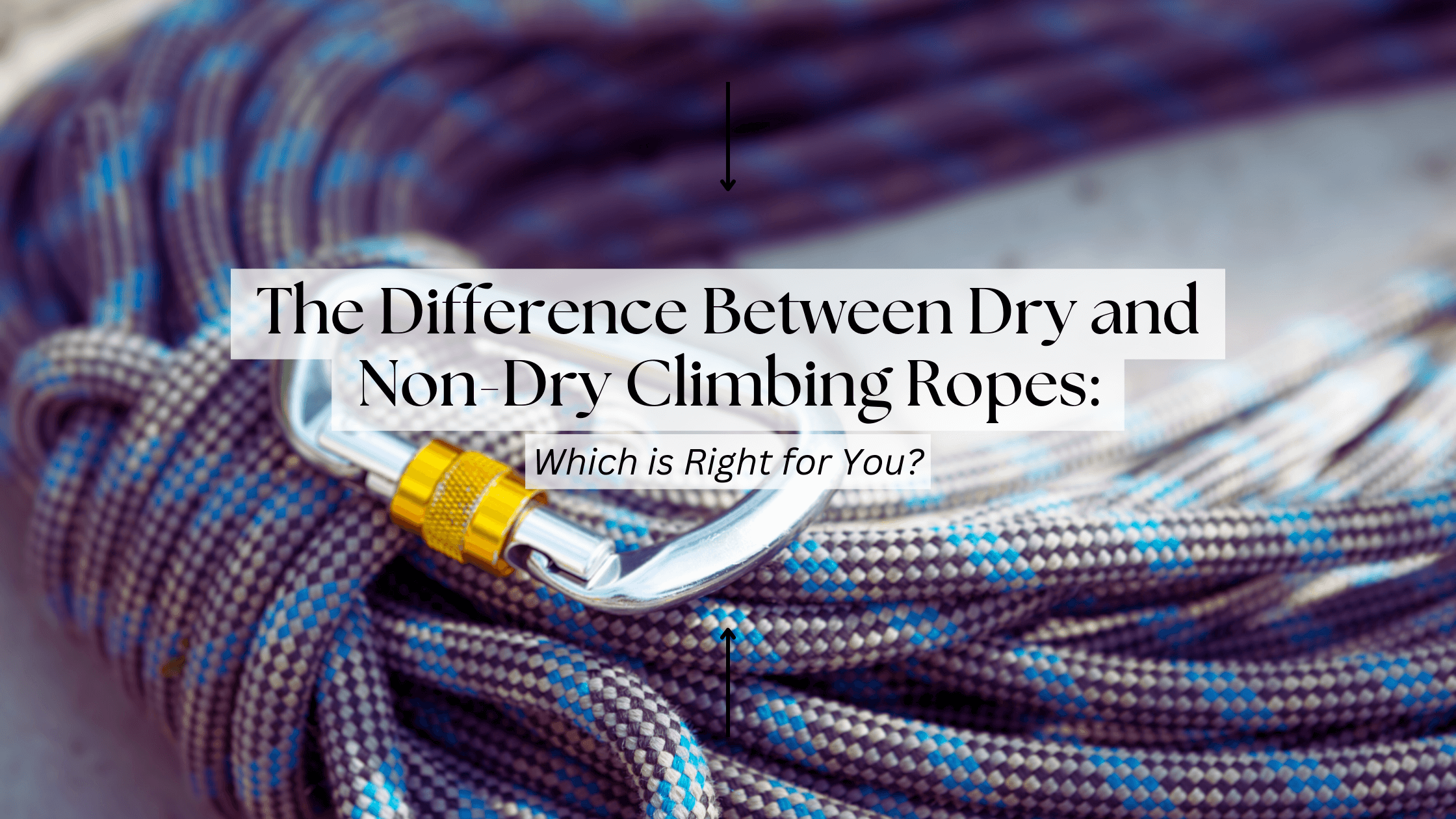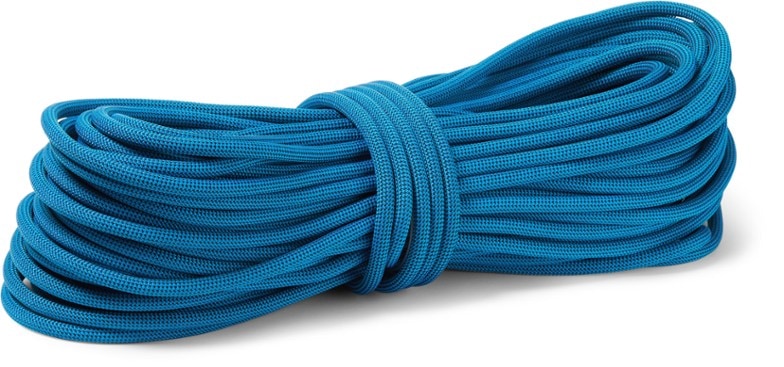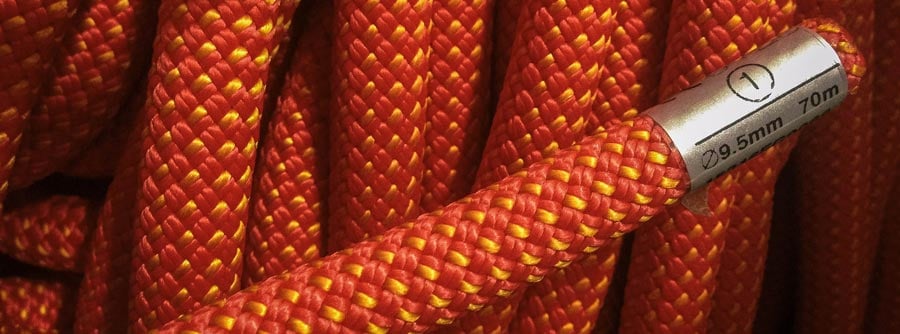What is the Difference: Dry vs. Non-Dry Climbing Ropes
A dry climbing rope has a water-repellent coating, whereas a non-dry rope does not. This coating protects the rope from moisture and freezing in cold environments.
Contents at a Glance
ToggleClimbing ropes are essential for safety during various climbing activities. They come in two primary types: dry and non-dry. Dry ropes feature a special treatment that repels water, making them ideal for ice climbing or mountaineering where the rope may come into contact with snow or water.
This treatment helps prevent the rope from becoming heavy, freezing, or losing strength when wet. Non-dry ropes, while often more affordable, are better suited for dry conditions. They absorb water, which can make them heavier and less durable in wet conditions. Choosing the right rope depends on the specific needs of the climb and the environment. It’s crucial for climbers to understand the conditions they’ll face and select a rope that offers the best performance and safety for their adventure.

Credit: inspirerock.com
Dry Vs. Non-dry Climbing Ropes: The Basics
Climbers rely on their ropes for safety and performance. Two main types exist: dry and non-dry. Each serves a specific purpose. Understanding the difference is crucial for making the right choice.
Core Characteristics Of Climbing Ropes
Climbing ropes have unique features. They must be strong, flexible, and durable. They come in various lengths and diameters. Climbers choose based on their adventure type. The core and sheath make up these ropes. The core bears the load while the sheath protects it.
- Dynamic ropes stretch under load, absorbing fall energy.
- Static ropes stretch very little, ideal for rappelling and rescues.
Dry-treated Ropes Explained
Dry-treated ropes have a special coating. This coating repels water and dirt. It extends the rope’s life. Dry ropes perform well in wet conditions. Climbers use them for ice climbing and mountaineering.
| Benefits of Dry Treatment |
|---|
| Water resistance |
| Dirt resistance |
| Increased durability |
Non-dry Ropes: What Sets Them Apart
Non-dry ropes lack the water-resistant coating. They absorb water. This makes them heavier and less suitable for icy conditions. They are ideal for dry, indoor, or fair-weather climbing. Non-dry ropes are generally less expensive.
- More affordable than dry-treated ropes
- Suitable for indoor and dry outdoor climbing
- Not water-resistant, can get heavier when wet

Credit: www.rei.com
Material And Construction
Understanding the difference between dry and non-dry climbing ropes starts with their material and construction. Let’s dive into the specifics of what makes these ropes unique and how they’re built to handle different climbing environments.
Common Materials Used In Rope Making
Climbing ropes consist of materials designed for strength and flexibility. The most common ones include:
- Nylon: Known for its durability and elasticity.
- Polyester: Offers good abrasion resistance.
- Dyneema: For high strength at a lighter weight.
How Ropes Are Constructed
The construction of a climbing rope is a precise process. It involves:
- Twisting fibers: Long strands form the core and sheath.
- Braiding the sheath: This protects the core and provides grip.
- Applying treatments: Dry ropes receive water-resistant coatings.
Dry ropes have treatments that protect against water and dirt. Non-dry ropes lack this protective layer but still perform well in dry conditions.
The Importance Of Dry Treatment
Climbers face many challenges. Wet ropes are one of them. A dry climbing rope can change the game. It resists water. This means better safety and performance. We will explore why dry treatment is a must for climbing ropes.
Benefits Of Dry-treated Ropes
- Enhanced Lifespan: Dry-treated ropes last longer. They resist dirt and abrasion.
- Consistent Performance: They perform well in wet conditions. They stay light and flexible.
- Reduced Water Absorption: They absorb less water. This helps to prevent freezing in cold climates.
Situations Where Dry Treatment Is Crucial
- Ice Climbing: Dry ropes are essential. They prevent water absorption and freezing.
- Mountaineering: In snowy conditions, dry ropes are safer. They don’t become heavy with water.
- Multi-pitch Routes: Here, ropes can drag through wet areas. Dry treatment helps to maintain rope integrity.
When To Choose Non-dry Ropes
Choosing the right climbing rope is crucial. Non-dry ropes are perfect for certain situations. Let’s explore when to pick these.
Advantages Of Non-dry Ropes
- Cost-effective: Non-dry ropes are generally less expensive than dry ropes.
- Easier handling: These ropes are softer, making them easier to knot and manage.
- Ideal for beginners: Their simplicity and cost make them great for new climbers.
Ideal Conditions For Non-dry Rope Usage
Non-dry ropes excel in dry, indoor environments.
| Environment | Usage |
|---|---|
| Indoor climbing gyms | Safe from moisture, non-dry ropes perform well. |
| Dry outdoor areas | When there’s no forecast of rain or snow. |
In dry conditions, non-dry ropes offer excellent performance and durability.
Performance In Different Climbing Conditions
Choosing the right climbing rope is crucial for safety and performance. Ropes must handle various conditions. Dry and non-dry ropes react differently in these environments. This section digs into how each rope type performs in different climbing conditions.
Wet Environments And Rope Performance
Dry ropes have a special coating. This coating repels water. It keeps the rope dry and light. Wet ropes become heavy and difficult to handle. They also risk freezing in cold conditions. Non-dry ropes absorb water. This can lead to faster wear and compromised safety.
- Dry ropes:
- Repel water effectively
- Stay lightweight when wet
- Perform well in snow and ice
- Non-dry ropes:
- Absorb water
- Become heavier and harder to manage
- May freeze and lose flexibility
Impact Of Dirt And Dust On Rope Longevity
Dirt and dust can damage ropes. They grind into the material during use. This weakens the rope over time. Dry ropes resist this penetration better than non-dry ropes. Their coating acts as a barrier. This extends the rope’s life. Non-dry ropes lack this protection. They are more vulnerable to contaminants.
| Rope Type | Resistance to Dirt | Longevity |
|---|---|---|
| Dry Rope | High | Longer |
| Non-Dry Rope | Low | Shorter |
Regular cleaning is vital for non-dry ropes. It helps maintain their condition. Dry ropes still need cleaning. But they need it less often due to their protective layer.

Credit: www.rei.com
Durability And Lifespan
The longevity of your climbing rope is a critical aspect of your gear’s reliability and safety. When choosing between a dry-treated and a non-dry rope, understanding the differences in durability and lifespan can guide you to make an informed decision. Both types of ropes serve their purpose, but their lifespans can vary significantly based on their treatments and the conditions they’re exposed to.
Dry-treated Vs. Non-dry Rope Durability
Dry-treated ropes are engineered to resist water and abrasion. This treatment adds a protective layer, making them more suitable for harsh conditions. Non-dry ropes, on the other hand, lack this coating. They may absorb water and wear out faster when exposed to moisture or freezing temperatures. This can make dry ropes more durable and often the preferred choice for climbers who face varied environments.
Factors Affecting Rope Lifespan
Several factors can impact the lifespan of your climbing rope:
- Frequency of use: More climbs mean more wear.
- Exposure to elements: UV rays and moisture can degrade fibers.
- Type of climbing: Sharp edges and falls affect rope integrity.
- Proper storage: Keep it dry, cool, and away from chemicals.
- Maintenance: Regular cleaning and inspection extend rope life.
By considering these factors, climbers can ensure their ropes stay strong and reliable for as long as possible.
Safety Considerations
Understanding the difference between dry and non-dry climbing ropes is crucial for your safety. Dry ropes are treated to resist water and dirt, while non-dry ropes are not. This treatment affects the rope’s performance and safety, especially in wet conditions.
Rope Safety Ratings And What They Mean
Every climbing rope comes with safety ratings that indicate its strength and durability. These ratings include the fall rating, impact force, and static elongation. Understanding these terms is essential for choosing the right rope for your climbing needs.
| Rating Type | Description | Importance |
|---|---|---|
| Fall Rating | Number of falls a rope can withstand | Higher numbers mean better durability |
| Impact Force | Energy the rope transmits during a fall | Lower numbers mean softer falls |
| Static Elongation | How much the rope stretches with weight | Lower percentages mean less stretch |
Always check these ratings on the rope’s label before buying.
Maintaining Your Rope For Safe Climbs
Maintaining your climbing rope is key to ensuring its performance and longevity. Here are some tips to keep your rope in top condition:
- Regular Cleaning: Wash your rope with mild soap and water to remove dirt and grit that can weaken it.
- Dry Properly: After washing, dry your rope away from direct sunlight.
- Regular Checks: Before and after climbs, inspect your rope for signs of wear or damage.
- Proper Storage: Store your rope loosely coiled in a cool, dry place away from chemicals.
Following these steps helps maintain the rope’s integrity and safety.
Cost And Value
Understanding the cost and value of climbing ropes is key. Climbers often debate over dry and non-dry ropes. These differences impact price and usability. Let’s explore the costs and how to choose the best rope for your climbing adventures.
Comparing The Cost Of Dry And Non-dry Ropes
Dry ropes are more expensive than non-dry ropes. This is due to the water-repellent treatments they undergo. This treatment protects the rope from moisture and freezing. Non-dry ropes lack this treatment, making them less costly.
| Type of Rope | Average Cost |
|---|---|
| Non-Dry Rope | $150 – $200 |
| Dry Rope | $200 – $300 |
Determining The Best Value For Your Climbing Needs
Choosing the right rope involves more than just the price. Consider these points:
- Climbing Environment: Wet conditions? Choose a dry rope.
- Frequency of Use: Climbing often? Invest in durability.
- Long-Term Value: Higher upfront cost could mean longer lifespan.
Non-dry ropes work well for dry, indoor settings. They offer good value for casual climbers. Dry ropes excel in outdoor and icy conditions. They are perfect for avid climbers seeking long-term performance. Assess your climbing needs to find the best rope without overspending.
Care And Maintenance Tips
Care and Maintenance Tips for your climbing rope are essential to ensure safety and longevity. Whether you own a dry or non-dry rope, proper upkeep can significantly extend its life. Follow these guidelines to keep your rope in top condition.
Best Practices For Rope Care
- Inspect regularly for signs of wear or damage.
- Avoid stepping on the rope to prevent dirt from grinding into the fibers.
- Limit exposure to direct sunlight and chemicals.
- Use a rope bag to minimize contact with the ground.
- Follow the rope’s recommended lifespan by the manufacturer.
Cleaning And Storing Your Climbing Rope
Keeping your rope clean and well-stored is crucial. Here’s how:
- Shake out any loose dirt and debris.
- Wash with mild soap and cool water when needed.
- Air-dry the rope away from direct heat or sunlight.
- Coil or loosely drape the rope for storage.
- Store in a cool, dry place away from sharp objects.
| Action | Tip |
|---|---|
| Inspect | Check before and after use. |
| Clean | Use gentle products. |
| Store | Keep in a rope bag. |
| Avoid | Don’t expose to harsh elements. |
Making The Right Choice
Making the Right Choice for your climbing adventure starts with understanding the gear. When it comes to ropes, climbers must choose between dry and non-dry options. Each type serves a specific purpose. This decision can impact safety, performance, and enjoyment. Knowing the differences ensures you select the best rope for your climbing needs.
Assessing Your Climbing Goals And Rope Needs
Before purchasing a rope, consider the climbing environment and your goals. Dry ropes have water-repellent treatment, making them ideal for icy or wet conditions. Non-dry ropes absorb water, becoming heavy and prone to damage in similar environments. Here’s how to assess your needs:
- Check the weather: Frequent climbs in wet conditions necessitate a dry rope.
- Analyze the terrain: Icy or snowy ascents require ropes that resist moisture.
- Plan for the unexpected: Sudden weather changes justify a dry rope for safety.
- Consider your climbing style: Dry ropes are also beneficial for frequent rappelling or top-roping.
Consulting With Experts And Experienced Climbers
Expert guidance is invaluable. Experienced climbers provide insights based on real-world usage. They can recommend specific ropes for your activities. Visit local climbing shops, join climbing forums, and participate in climbing groups. Here’s a quick guide for consultation:
| Type of Climber | Type of Rope Recommended |
|---|---|
| Beginner | Non-dry rope for basic, dry conditions |
| Intermediate | Dry rope for varied conditions |
| Expert | Specialized dry rope for extreme environments |
Remember, a rope’s lifespan and safety depend on proper use and care. Always follow the manufacturer’s guidelines for maintenance. Your rope is your lifeline. Select it with care and climb with confidence.
Frequently Asked Questions
Should I Get A Dry Or Non-dry Rope?
Choose a dry rope for climbing in wet conditions or alpine environments to prevent water absorption. Opt for a non-dry rope for dry climates and indoor use to save on costs.
What Does A Dry Climbing Rope Mean?
A dry climbing rope is treated with a water-repellent coating to resist water absorption, enhancing safety and durability in wet conditions.
Are Dry-treated Ropes Worth It?
Dry-treated ropes are worth the investment for climbers. They resist water absorption, reduce weight, and maintain performance in wet conditions, extending their lifespan and enhancing safety.
Can You Wash A Non Dry Climbing Rope?
Yes, you can wash a non-dry climbing rope. Use lukewarm water and mild soap. Gently scrub, then rinse thoroughly. Avoid direct sunlight and dry flat. Regular cleaning extends its lifespan.
Conclusion
Choosing between a dry and non-dry climbing rope depends on your climbing environment and needs. Dry ropes are essential for wet conditions, offering safety and durability. For dry terrains, non-dry ropes are sufficient and cost-effective. Consider your typical climbing conditions to make the best choice for your adventures.

